Transferts monétaires et mobilité humaine
Les transferts monétaires sont souvent utilisés lors de crises afin de répondre aux besoins des personnes migrantes. Dans cette page, vous trouverez des ressources sur les transferts monétaires et la migration.

La Croix-Rouge se prépare à fournir une aide humanitaire aux migrant·es de la caravane sur le point de quitter le Honduras pour le Guatemala.
©Johannes Chinchilla / FICR.
Conflits, crises économiques et catastrophes sont autant de raisons ayant contraint des personnes à fuir et à traverser des frontières dans des conditions éprouvantes et risquées, en quête de sécurité et de moyens de subsistance. En 2020, le nombre de personnes déplacées de force s’est envolé au niveau sans précédent de plus de 80 millions de personnes, soit près du double du nombre enregistré il y a une dizaine d’année. Cette tendance s’aggrave et les effets du changement climatique menacent de déplacer jusqu’à 200 millions de personnes d’ici 2050.
L’assistance monétaire est de plus en plus utilisée afin de répondre aux besoins des personnes en situation de déplacement. On y a eu recours à grande échelle dans différents contextes de migration, en Europe en 2015 jusqu’au Venezuela pour « los caminantes ». Elle a également été utilisée dans d’autres crises migratoires, notamment en Amérique centrale, au Sahel, en Méditerranée et dans la Corne de l’Afrique. L’assistance monétaire est à l’heure actuelle l’une des principales formes d’aide apportée aux populations déplacées en Ukraine et dans les pays voisins.
Il existe une myriade de perspectives et de définitions concernant le mot « migrant·e » et la façon dont les humanitaires doivent agir. C’est pourquoi nous ne choisissons pas une définition unique pour le moment, étant donné que les discussions sur l’assistance monétaire et la migration en sont encore à leurs prémices et que le langage évolue encore.
Documenter et partager les données probantes donnera lieu à des interventions plus efficaces. Cette page contient une sélection de ressources utiles concernant la migration et le recours à l’assistance monétaire. Elle sera mise à jour au fil des discussions ayant lieu dans les espaces humanitaires des transferts monétaires.
Priorités actuelles
Afin de contribuer aux progrès relatifs à cet enjeu, nous nous engageons à :
- soutenir la création de données probantes aux niveaux régional et mondial ;
- contribuer aux solutions pratiques visant à mettre en œuvre les transferts monétaires auprès des personnes migrantes ;
- organiser des discussions sur les enjeux majeurs basées sur des données probantes.
Contenu récent
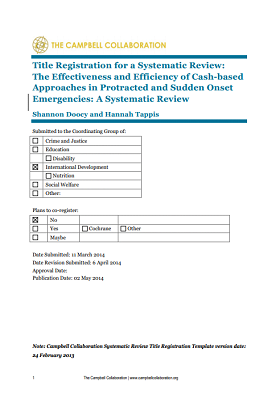
The Effectiveness and Efficiency of Cash-based Approaches in Emergencies: A Systematic Review (Background and Objectives)
Report
This document provides the background, literature review, and objects of the review itself, which is available here. Cash-based approaches have been used for development purposes for a number of decades, particularly within social protection interventions in low- and middle-income countries. Over the...

Liberia Ebola Response
Presentation
ICRCs EVD Cash response program had to be designed under a rare circumstance of insufficient baseline data on EVD impact on household level and limited opportunity to contact intended beneficiaries for a detailed assessment/ proper situational analysis.

AAP Minimum Standards for Complaints & Feedback
Guidelines and Tools
A complaints and feedback mechanism (CFM) is a formal mechanism for receiving and responding to complaints from people in communities where we implement programmes. The main objectives are to increase the influence of affected communities over programmes, ensure that incidences of dissatisfaction with the...

Pre-crisis Market Mapping and Analysis (PCMMA): Training Report
Report
In recent years, humanitarian organisations have been re-examining their
responses to emergencies. Many have begun experimenting with cash-based initiatives alongside or in place of conventional relief distributions of food and non-food items, and local procurement is being encouraged wherever possible....
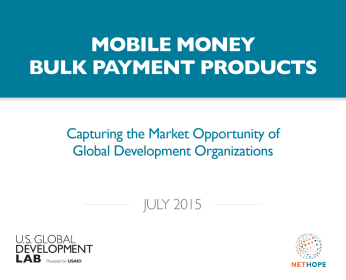
Mobile Money Bulk Payment Products: Capturing the market opportunity of global development organizations
Presentation
International relief and development organizations (DOs) receive significant aid funding from donors, which they regularly disburse in high volume, low value payments to millions of recipients for program and operational expenses. DOs and donors are increasingly using and promoting the use of new digital...
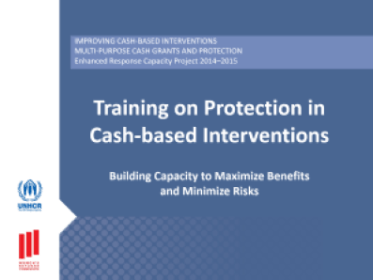
Protection in Cash-based Interventions Training: Building capacity to maximize benefits and minimize risks
Guidelines and Tools
This participatory curriculum is based on the inter-agency Guide for Protection in Cash-based Interventions (CBIs). The one-day training provides practical instruction for analysing and monitoring protection risks and benefits in CBIs. Slides, facilitators’ guide, case studies, and other materials for...

Guidance Notes: Cash Transfers in Livelihoods Programming- West Africa
Guidelines and Tools
A growing acceptance of cash transfers as an inter-sectorial tool is accompanied by a better understanding of this approach and its potential to break the cycle of poverty, after much discussion on the role cash transfers have to play in building resilience. In the Sahel, food security experts have...
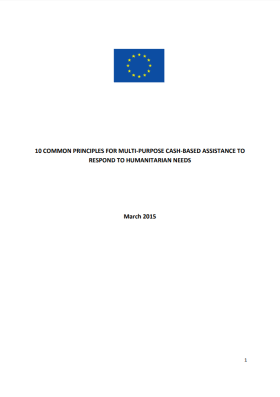
10 Common Principles for Multi-Purpose Cash-Based Assistance to Respond to Humanitarian Needs
Policy paper
These principles are intended to complement existing guidance on cash-based assistance and policy positions on those thematic areas which lend themselves to a multi-purpose approach. Donors and their partners are encouraged to take these principles into account in designing and implementing their...
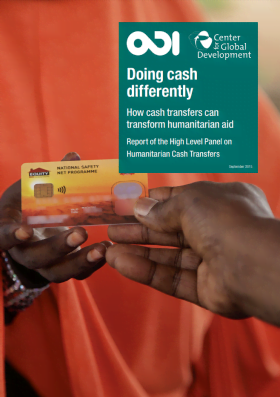
Doing Cash Differently: How cash transfers can transform humanitarian aid?
Policy paper
This report commissioned by the Overseas Development Institute highlights why giving aid directly in the form of cash is often a highly effective way to reduce suffering and to make limited humanitarian aid budgets go further. The publication, ,written by the High Level Panel on Humanitarian...

Household Cash Transfer Assessment – Typhoon Haiyan Recovery Response
Report
An estimated 16.1 million people were affected by typhoon Haiyan, with 1.1 million damaged or destroyed homes and as many as 4.1 million people displaced – nearly four times as many as those left homeless by the 2004 Indian Ocean tsunami. At least 6,300 people lost their lives and another 5.9...

Exemple d’accord de confidentialite
Guides et outils
GUIDE ELAN POUR L’ÉVALUATION D’ARGENT MOBILE ET L’ÉTABLISSEMENT DE CONTRAT

The CALP Network At A Glance
Guidelines and Tools
The CALP Network is a global partnership of humanitarian actors engaged in policy, practice and research within cash transfer programming (CTP). Formed of a community of practice including over 150 organisations and more than 5,000 individuals in the humanitarian sector, the CALP Network is based on...
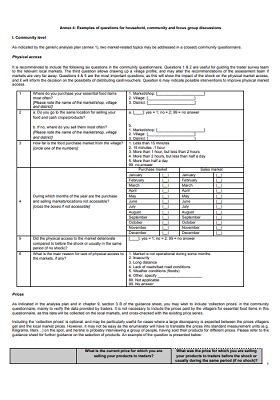
Annex 4: Examples of questions for household, community and focus group discussions
Report
It is recommended to include the following six questions in the community questionnaire. Questions 1 & 2 are useful for guiding the trader survey team to the relevant local markets. The third question allows drawing up a village profile, and may alter the recommendations of the assessment team if markets...
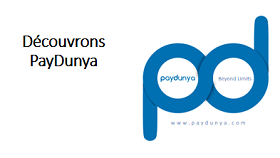
Découvrons PayDunya
Rapport
PayDunya est un fournisseur de service de paiement qui permet au e-merchant et e-businessman partout dans le monde d’accepter les paiements de leurs clients africains depuis le mobile money, les services de transfert d’argent et les cartes bancaires.
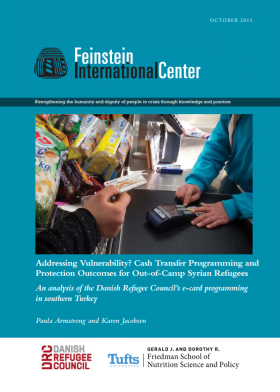
Addressing Vulnerability? Cash Transfer Programming and Protection Outcomes for Out-of-Camp Syrian Refugees
Report
This report explores key issues concerning vulnerability, targeting, and protection in cash transfer programming (CTP) by analyzing a Danish Refuge Council (DRC) project in southern Turkey. It is based on an ongoing “action research” collaboration between DRC and the Feinstein International Center...
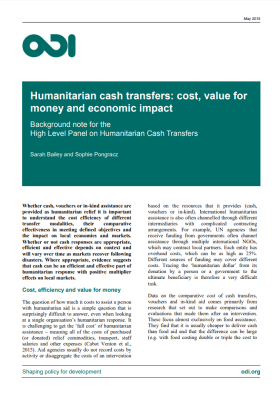
Humanitarian Cash Transfers: Cost, value for money and economic impact
Policy paper
The question of how much it costs to assist a person with humanitarian aid is a simple question that is surprisingly difficult to answer, even when looking at a single organisation’s humanitarian response. It is challenging to get the ‘full cost’ of humanitarian assistance – meaning all of the...

Transferts monétaires sans condition: perspectives et points de vue des bénéficiaires en RDC, au Népal et aux Philippines
Rapport
La distribution d’aide monétaire dans des situations d’urgence humanitaire se généralise et fait l’objet d’amples débats au sein du secteur humanitaire en abordant des sujets variés, qu’il s’agisse de la reconnaissance à un haut niveau de l’assistance monétaire comme outil capable...
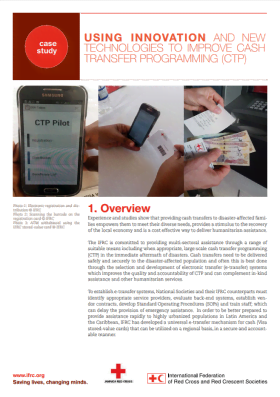
Using Innovation And New Technologies to Improve Cash Transfer Programming (CTP)
Report
Experience and studies show that providing cash transfers to disaster-affected families empowers them to meet their diverse needs, provides a stimulus to the recovery of the local economy and is a cost effective way to deliver humanitarian assistance. The IFRC is committed to providing multi-sectoral...
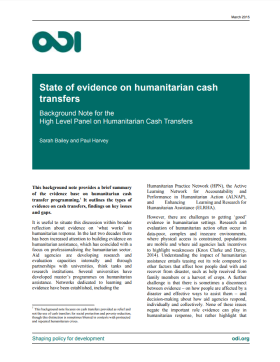
State of Evidence on Humanitarian Cash Transfers
Policy paper
The “State of evidence on humanitarian cash transfers” background note provides a brief summary of the evidence base on humanitarian cash transfer programming. The report also outlines the types of evidence on cash transfers, findings on key issues and gaps. This publication is an output of the...

Markets in Crises: The 2010 Floods in Sindth, Pakistan
Case Study
Floods in Pakistan in 2010 inundated a wide swath of territory, affecting 18 million people and killing approximately 2,000. The disaster also affected businesses, from some of the largest factories and most fertile agricultural land in the country to small village shops. Many businesses closed, either...